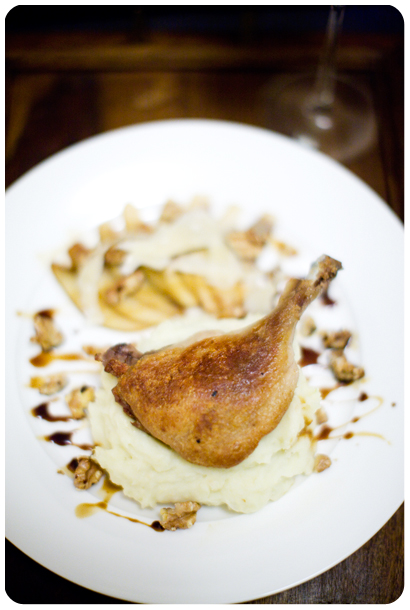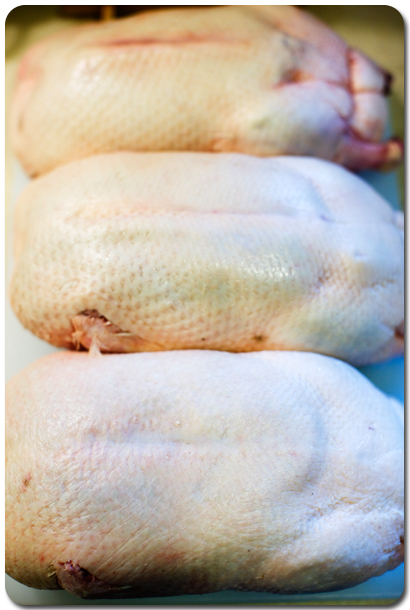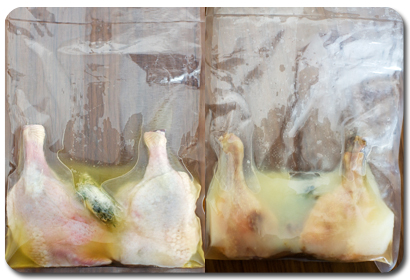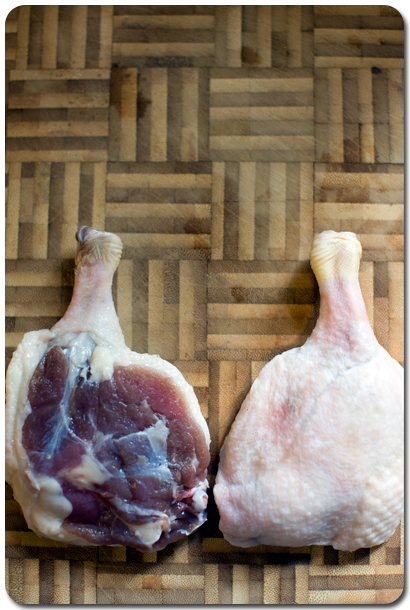Thursday, February 4th, 2016...4:59 pm
Sous Vide Duck Confit

WHOA HELLO. Good grief, how on earth did the entirety of 2015 pass me by without a single update? [Insert chastised face.] Well, luckily for me, I kinda have a couple of days left to make sure the year of the sheep doesn’t completely go by unblogged as well. The good news is, this post is coming out well in good time for you guys to get cracking on this over the weekend, so you have a fantastic dine in option for Valentine’s Day this year to spoil your loved ones with. Because who goes out for Valentine’s Day anymore, really? (Okay fine, I do. Lol. Don’t judge.)
I’ve actually been sitting on this particular post for quite a long time – something to the tune of 5 years or some nonsense like that. In my defence, I’ve been playing around with various aromatic combinations and sous vide times and temperatures, which is also why the photos might not 100% match up with the recipe below. Ever since I first dipped my toes into sous vide, like any self-respecting cooking nerd I immediately took to SOUS VIDING ALL OF THE THINGS. Which, obviously, wore off after a while. I’ve since switched from the Sous Vide Supreme to an immersion circulator (specifically, the Nomiku, which I love to BITS. I love it so much I have 2 units, and will have a third once the international wifi nom starts shipping haha), and while most of my experimental low temperature cooking as slowed to a halt, I actually use it much more regularly on day to day food prep and cooking.
One thing I really like using low temperature (and sous vide) cooking for is batch cooking. Good meat can be really expensive here in Hong Kong, so every now and then I’ll buy a big batch of beef and bag it up into single or double serve portions, cook it all at once, and then freeze it for easy and quick weeknight dinners. It’s cost effective, it’s space efficient (bags have the added benefit of not wasting headspace over containers), and things last longer that way (much less freezer burn).

Now, although most of the benefits of low temperature cooking come from the different textures one can achieve (e.g. turning a tough/braising cut of beef into something you can serve as a steak, complete with a pink interior), the main benefit from cooking duck confit sous vide comes from the packing. Thing is, duck doesn’t really benefit from being confited a lower temperature than with traditional cooking methods. However, if you cook the duck in a low temperature bath in plastic bags, you get to use much less fat than if you needed to lay it out in a roasting tray and cover all of the legs with fat. You also can then store the duck legs (in pairs, or individually) in the bags they were cooked in, which means it’s super easy to pull a bag out, warm it gently to soften the fat, crisp up the skin, and hey presto duck confit as an easy weeknight dinner! Whodathunk. Because of the fairly long cook and the whole time-consuming nature of breaking down ducks, I’d probably still recommend breaking down at least 2-3 birds at once and making a weekend project of it, but if you’ve got any duck fat sitting around (from previous cooks, or you know, if you nicked some off me), there’s no reason at all you can’t just buy a couple of duck legs and not need this to be such a grand affair.

Some people may have concerns about pulling a strong vacuum on bone-in duck legs. Birds have hollow bones, so when you pull a hard vacuum, some of the bits from inside the bones tend to come out into the surrounding muscle tissue, which – especially in the case of chicken – usually mean a reddish stain on the meat, even when it is cooked for a long time. In fact, to cook out that slightly unnerving pink colour, you’d probably have to cook it to such a high temperature that it would defeat the purpose of low temperature cooking at all. However, with duck confit, because you’ll be cooking it at such high temperatures (basically anything in excess of 75-80ºC or so), you don’t have to worry about that same problem.
Anyway. I hope you’ve all been well, and not completely forgotten about me/removed me from your feeds. I’d make some vague promises about blogging more often but we all know that’s the most surefire way to completely kill this blog off haha so. With that, happy (belated) 2016, and here’s wishing all of you a happy and prosperous upcoming year of the monkey!
Sous Vide Duck Confit
3 ducks – broken down into 6 legs, 6 breasts, excess fat and skin reserved
3 bay leaves
6 sprigs of thyme (or rosemary, or both)
a nice bunch of flat-leaf parsley (about double the amount of thyme)
3 cloves garlic
6 strips orange peel
1.5 tbsp freshly ground black pepper
kosher/sea salt (see below for amounts)
Set aside duck breasts for another use. (I like to buy my ducks whole and chilled, so I can freeze the ducks for cooking separately.) Cut the excess fat and skin up into small pieces and add to a deep saucepan with about 60-100ml water over medium-low eat to render, lowering the heat once the water has boiled off. Once all the bits are crispy, strain it, reserving the crispy bits for the world’s most delicious instant noodle topping. Chill the fat in the fridge until you’re ready to cook the legs.

Weigh your duck legs. You want to use about 10% salt by weight, i.e. if your duck legs weigh 1kg, you’ll need about 100g salt total. A little more or less is fine, but you want enough salt to make sure all surfaces of the duck are generously covered wth salt while it cures.
Note: If you’re only doing 2 legs, just scale down the aromats as well. As a general rule, I like roughly 1 sprig of thyme, 1 clove of garlic, 1/2 tbsp pepper and 2 strips of orange zest per pair of duck legs. But any combination of herbs and spices that you’d usually pair with duck – like juniper, allspice, rosemary, shallots, or even coffee – would go well, so feel free to get creative with this.
Blitz up the bay, thyme, parsley, garlic, and orange peel with the salt in a food processor or mortar and pestle. Using a resealable bag or a deep dish that will fit your duck legs snugly in a single layer, scatter half the salt cure evenly, lay the duck legs over the salt, then scatter the rest of the salt over the top. Press all the air out of the bag, or clingfilm your dish securely, and chill in the fridge for 24 hours.
Preheat your water bath to 80ºC.

Remove the duck legs from the salt cure, rinse off any excess salt under cold running water, and pat them dry. The flesh should be firm to the touch and deeper in colour. Bag the legs (either individually or in pairs), with 1-2 tbsp of duck fat per leg. Seal the bags, and cook in your water bath for 6-8 hours.
Once the 8 hours is up, remove the bags from the water bath and chill. Ideally, let the confited duck legs rest in the fridge overnight before serving, and they’ll keep in the fridge for a pretty long time. I hesitate to give any specific amounts of time, but the duck legs are pasteurised, and traditional duck confit lasts for months if stored in a good amount of fat. If in doubt, they also will last at least 6 months frozen (I’ve kept mine frozen for over a year without any appreciable dip in quality though).
To serve, warm the bags up slightly in warm water so the fat softens and you can slide the duck legs out easily without them falling apart. The meat will be very, very tender, so handle gently. You’ve got a couple of options on how to reheat them: if you’re doing a big batch, the best way is probably skin side up on a roasting tray under a hot broiler (crank it up to 200-250ºC) for about 5-10 minutes, or until the skin is nicely browned, but my personal preference is for laying them skin side down in a preheated cast iron pan (you shouldn’t need any extra fat). Reserve the fat and juices from the bag for roasting up some potatoes or making the tastiest salad dressing in the world to go with the confit.
Yield: makes 6

Comments are closed.